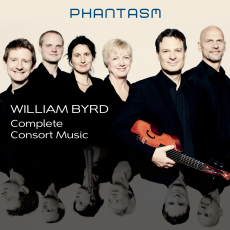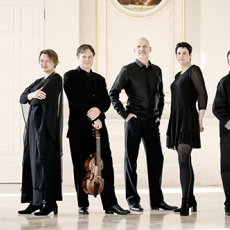Phantasm - William Byrd - Australian Viola da Gamba Society
William Byrd (c.1540 - 1623) was one of the greatest composers of Elizabethan England. A student of Thomas Tallis, Byrd's
music encompasses many of the different musical forms of the period and demonstrates remarkable invention, beauty, subtlety and a formidable mastery of polyphony. Music for viol consort makes up a compact but significant part of Byrd's legacy and with this 80 minute disc, English viol consort Phantasm presents this oeuvre in its entirety, omitting only the spurious or inadequately reconstructed works such as the In Nomine a5 (I) and other incomplete hymn settings. This is, to my knowledge, only the second all-Byrd recording of consort music, the other being a CD released by Fretwork in 1994, a disc with four fewer works than that currently under review. Consort music was a medium that gave Byrd considerable compositional freedom, as it was music largely composed ‘for music's sake', without the constraint of text or liturgy. It is truly fascinating to hear the total extant consort music left to us by Byrd, composed across a span of some 40 years, on a single CD. In the interesting and scholarly liner notes, Phantasm's director Laurence Dreyfus proposes probable compositional dates for each piece; a constantly evolving style that never ceases in its experimentation is clearly evident. From the polyphonic enrichment of devotional hymns, beautiful, contemplative and spare in texture, through in nomines of heartbreaking transparency, an early and very dense 6-part fantasia, clever and inventive sets of variations on popular tunes such as Browning, forays into dances with dignified pavans and refined galliards and finally fantasias which are stunningly beautiful in their polyphonic complexity, astonishingly intricate with only three or four voices - music in the purest sense. Dreyfus quotes Morley in describing these late fantasias: "Here, following Thomas Morley (1597), ‘more art may be shown than in any other music because the composer is tied to nothing, but may add, diminish, and alter at his pleasure'. In taking a succession of unmarked ‘points', each laden with its own refined gradients of character, Byrd ‘wrests and turns [the point] as he wishes', forming a kaleidoscope of intense yearning and delight."
Rather than arrange the music chronologically, Phantasm has chosen to order the works so that the different styles and
characters are continuously juxtaposed, as are the number of parts and therefore textures. This is, for me, a very successful approach that generates a logical musical flow and maintains ones interest as a listener. Under the direction of Laurence Dreyfus from the treble viol, Phantasm performs these works with an admirable unity of purpose, the well-matched instruments creating a kaleidoscopic blend of sound that yet allows individual voices to emerge and be heard in turn. The ensemble is faultless, the tuning excellent (I would be curious to know which temperament they chose) and the playing executed with a pleasing variety of articulations. In particular, I enjoyed the sense of energy and lively forward motion brought to the more active passages, which were beautifully contrasted with the more static moments of contemplation. The recording quality is clean and clear, with the acoustic of the Merton College Chapel, Oxford, being very suitable for the recording of this repertoire. This CD is a fine achievement, the music so interesting that it bears many repeated hearings, and I recommend it highly to any listener with an interest in music for viol consort.

